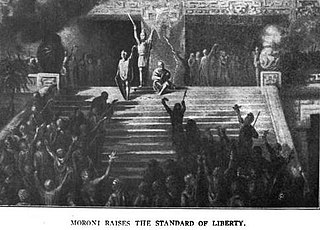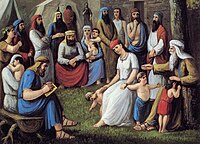
The Book of Alma: The Son of Alma, usually referred to as the Book of Alma, is one of the books that make up the Book of Mormon. The title refers to Alma the Younger, a prophet and "chief judge" of the Nephites. Alma is the longest book in the Book of Mormon and consists of sixty-three chapters, taking up almost a third of the volume.
The Book of Mosiah is one of the books which make up the Book of Mormon. The title refers to Mosiah II, a king of the Nephites at Zarahemla. The book covers the time period between ca 130 BC and 91 BC, except for when the book has a flashback into the Record of Zeniff, which starts at ca 200 BC, according to footnotes. Aside from stating that it was abridged by Mormon, the text says nothing about its authorship. Mosiah is twenty-nine chapters long.

In the Book of Mormon, the Nephites are one of four groups said to have settled in the ancient Americas. The term is used throughout the Book of Mormon to describe the religious, political, and cultural traditions of the group of settlers.

The Book of Mormon mentions three men named Helaman. The first was the son of King Benjamin, king of the united Nephite-Zarahemla kingdom who lived in the 2nd century BC. Besides his genealogy, information about the first Helaman is limited. His brother, Mosiah, became heir to the throne.

Alma is a Nephite prophet in the Book of Mormon. Initially a priest who serves in the court of King Noah, when a prophet named Abinadi preaches to the court Alma concurs with Abinadi and affirms that what the prophet said is true. For this, Noah banishes Alma and tries to have him killed. After leaving the court, Alma goes on to found a church among Noah's subjects. He eventually leads these churchgoers out from Noah's lands, through a sojourn under Lamanite rule, and to the land of Zarahemla, where their ancestors had come from a few generations earlier, where Alma becomes high priest of the Nephites' church.

King Noah is a Nephite king in the Book of Mormon who appears in the Book of Mosiah. Noah rules over a Nephite colony who came from Zarahemla and settled in the land of Lehi-Nephi, succeeding his father, Zeniff. In the Book of Mosiah, King Noah breaks away from his father's righteous teachings, committing "all manner of wickedness." Noah and his priests sentence the prophet Abinadi, who prophesied of his kingdom's downfall if they did not repent, to death by fire. During a Lamanite invasion, Noah and some of his people flee the land, and those who remain are subjected to Lamanite control. Noah attempts to forbid his men from returning to their families, and they burn him at the stake. Noah is succeeded by his son, Limhi.

In the Book of Mormon, Alma, the son of Alma is a Nephite prophet often referred to as Alma the Younger to distinguish him from his father, who is often referred to as Alma the Elder. These appellations, "the Younger" and "the Elder," are not used in the Book of Mormon; they are distinctions made by scholars, useful because both individuals were prominent during the same time period in the Book of Mormon's story and filled a similar cultural and religious role. Alma is the namesake of the Book of Alma.

In the Book of Mormon, Ammon is a prominent Nephite missionary and a son of King Mosiah. He originally opposes the church, but along with his brothers and Alma the Younger, is miraculously converted. Following his conversion he serves a mission to the Lamanites and converts Lamoni and his people.

Zeniff is a king in the Book of Mormon whose personal account is recorded in the Book of Mosiah. He is the father of King Noah and the grandfather of King Limhi. Zeniff is the first king of Nephite colonists who come from Zarahemla and settle in the land of Lehi-Nephi. The Nephites believe this land to be rightfully theirs by inheritance, even attempting to reclaim the land by force. In an expedition in which he spies for the Nephites, Zeniff claims to see good in the Lamanite inhabitants. He argues against a militaristic approach and causes an internal battle among the Nephite army. Zeniff later leads a group of Nephites back to Lehi-Nephi and establishes a peace treaty with the Lamanite king whose people inhabit the land. Zeniff’s people prosper with him as king, but the Lamanite king betrays their treaty and attempts to exploit them. Zeniff and his people successfully fight off the Lamanites’ multiple aggressions, and Zeniff's reign lasts about forty years, after which he passes the kingship to one of his sons, Noah. Scholarly interpretations have highlighted Zeniff's shifting perceptions of Lamanites, such as how his opinion changes when his people contends with the Lamanites and the role that Zeniff's narration plays in racializing Lamanites in the Book of Mormon.

In the Book of Mormon, Limhi is the third and final king of the second Nephite habitation of the land of Lehi-Nephi. He succeeds his father, Noah. Led by Ammon, Limhi and his people escape from the Lamanites with his people to the land of Zarahemla.

In the Book of Mormon, the waters of Mormon is a body of water where about two hundred Nephites are baptized.

In the Book of Mormon, chapters 9 through 22 of the Book of Mosiah are identified as the Record of Zeniff. These chapters contain the story of a group of Nephites, led by Zeniff, who leave the land of Zarahemla and return to their former land, known as the land of Nephi, which was then occupied by the Lamanites, their traditional enemies. Although the attempt to establish themselves among the Lamanites is successful for a short time, the people of Zeniff are ultimately enslaved and forced to pay tribute to the Lamanite king. They are later rescued by an expedition from Zarahemla sent to discover their fate. The Record of Zeniff records the reigns of Zeniff, his son Noah and grandson Limhi. The timespan is approximately 75 years.

According to the Book of Mormon, the plates of Nephi, consisting of the large plates of Nephi and the small plates of Nephi, are a portion of the collection of inscribed metal plates which make up the record of the Nephites. This record was later abridged by Mormon and inscribed onto gold plates from which Joseph Smith translated the Book of Mormon after an angel revealed to him the location where the plates were buried on a hill called Cumorah near the town of Palmyra, New York.

According to the Book of Mormon, Amaleki was one of several Nephite record keepers who maintained records on metal plates known as the plates of Nephi. The Book of Mormon refers to the small plates of Nephi and the large plates of Nephi. Nephi began writing on the small plates about 570 BC. Nephi's brother Jacob and his descendants began keeping records of sacred and religious matters on the small plates around 544 BC. Seven of Jacob's descendants, including Amaleki, wrote on the plates. Amaleki recorded his account on the plates about 130 BC. He states at the end of his writings that the plates are full. He received the plates of Nephi from his father Abinadom and penned 18 verses in the Book of Omni. He was the last person to write in the small plates of Nephi. Having no descendants, Amaleki gave the small plates to King Benjamin.
This chronology outlines the major events in the history of the Book of Mormon, according to the text. Dates given correspond to dates in the footnotes of the Church of Jesus Christ of Latter-day Saints edition of the Book of Mormon and to a Jaredite timeline proposed by Latter-Day Saint scholar John L. Sorenson.

Nehor is the founder of an apostate sect mentioned in the Book of Mormon around 90 BC in the first year of the reign of the judges. He teaches the Nephites that priests and teachers should be supported by their followers, and that all will be saved in the end. Nehor is brought before Alma the Younger for killing Gideon, a Nephite elder who argued with him. Alma accuses him of priestcraft and sentences him to death for enforcing his beliefs with violence. When executed, Nehor admits to teaching against the word of God.

In the Book of Mormon, Ammon is a Mulekite descendant and leader of a Nephite expedition from Zarahemla, sent to discover the fate of Zeniff and his people. Zeniff and his followers left Zarahemla and travelled to Nephi, their ancestral home, which was then in the possession of the Lamanites. This may have contributed to his expedition, not knowing the actual route to Nephi.

The following outline is provided as an overview of and topical guide to the Book of Mormon:









